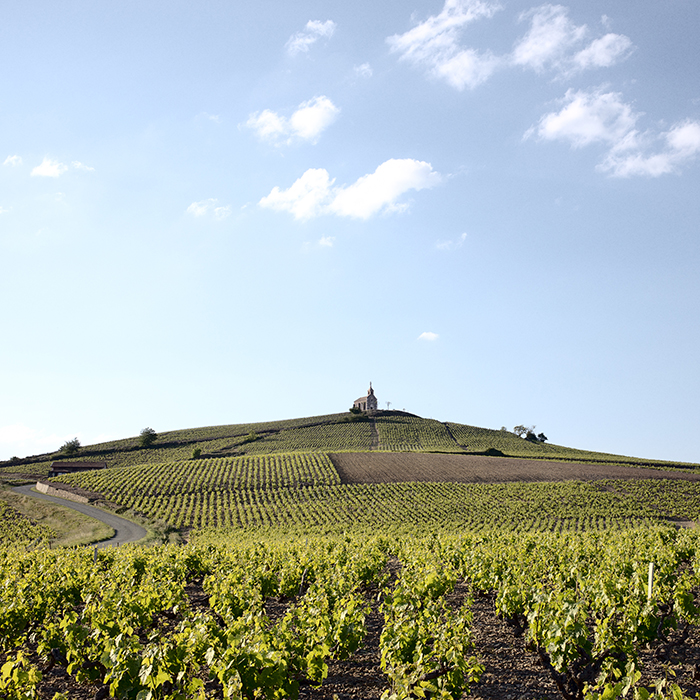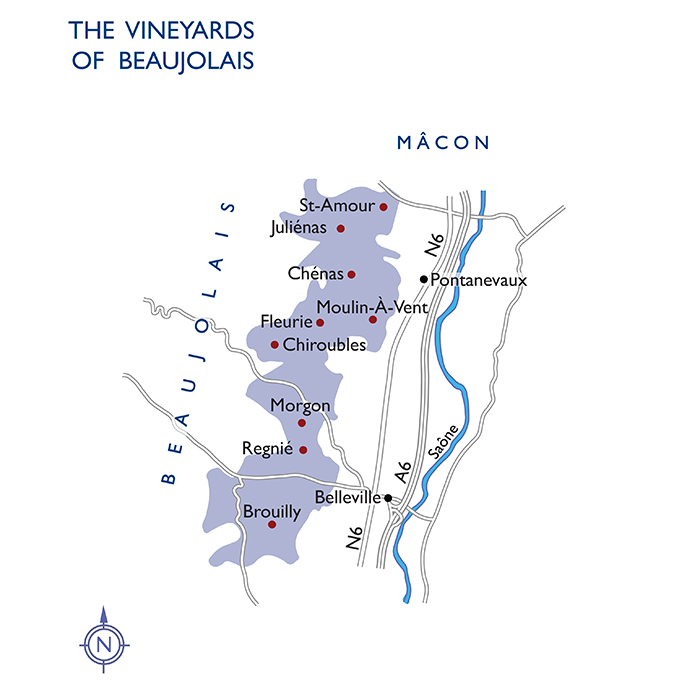Everything you need to know about Beaujolais
Author: Sophie Thorpe

Where is it?
Sitting between Burgundy and the Rhône, just south of the Mâconnais, Beaujolais (just over 15,000 hectares) is formed of rolling granite hills in the north, with the land flattening out in the south. Better wines will be labelled “Beaujolais-Villages” coming from the northern, hillier half – versus “Beaujolais” which can be sourced from anywhere in the region. The best wines come from the 10 classified villages, or Crus (see our quick guide to the most famous of these below).
What’s the story?
This is the home of Gamay – a grape rarely found elsewhere. Historically it was planted throughout Burgundy, but in 1395 Philip the Bold, Duke of Burgundy banned the variety – and today only small plots remain in the Côte d’Or, making their way into bottlings of Coteaux Bourguignons or Bourgogne Passetoutgrains (try those from Grivot or Lafarge). Although today Beaujolais sits in the shadow of Burgundy, in the early 20th century Beaujolais was as prestigious as its northern neighbour, commanding similar or in some cases higher prices.
In the wake of the Second World War, the region’s winemakers started selling Beaujolais Nouveau – youthful, fruit-forward wines that could be sold from the November following harvest. Made with carbonic maceration, these distinctively soft and fruity wines were soon sold around the world, wooing consumers with their hint of bubble gum and banana, representing as much as 60% of the region’s production in the 1980s. But a rebellion was brewing. A group of winemakers – including those dubbed the Gang of Four by Kermit Lynch (Jean-Paul Thévenet, Guy Breton, Jean Foillard and Marcel Lapierre) – started championing the old way of making wine, with sustainable farming, slow vinification and long maturation – an off-hands approach that made them, and the region, the darling of the natural wine scene.
Today the region is more exciting than ever, its cheap land prices luring a new generation of winemakers from around the globe, as well as famous names from Burgundy (including Lafarge and Liger-Belair). You’ll find swathes of gnarly bush vines cloaking the slopes, demanding work is done by hand, versus the more manicured trellised vines of Burgundy. These old bush vines produce some of the most exciting wines – complex and concentrated expressions of Gamay that can rival good red Burgundy.

What does it taste of?
There’s an extraordinary range of Beaujolais, but in general these are juicy and enticing wines: aromatically expressive, layered with red berry fruit, crunchy acidity, fine and inobtrusive tannins. They can range from more floral and delicate expressions to swarthy, dark and savoury wines that need time in the cellar. As Gamay ages – and in the hands of great winemakers, it does so very well – it becomes increasingly hard to distinguish from Pinot Noir.
What should I eat with it?
Thanks to its vibrant acidity, Beaujolais is deliciously food-friendly. While much of its charm lies in the fact that it can be savoured on its own, it’s particularly good with charcuterie, cheese and cold cuts – but bolder styles can stand up to steak or sausages, while roast chicken is a brilliant match. It’s quite possibly the perfect picnic wine.
Three to try
2019 Berry Bros. & Rudd Beaujolais-Villages by Desvignes: The first vintage of our own-label Beaujolais flew off the mostly virtual shelves, and the second has arrived just in time for an August full of barbecues and picnics. Made from a plot of 60-year-old vines, it’s succulent and undeniably moreish.
2018 Fleurie, Domaine Julien Sunier, Beaujolais: Julien Sunier is one of the region’s most famous names, known for his hands-off touch in the winery and brilliant wines. His Fleurie is mineral with constantly shifting aromas of violets and summer fruit.
2018 Moulin-à-Vent, Olivier Merlin, Beaujolais: Olivier Merlin is best known for his wines from the Mâconnais, but he also makes some superb Beaujolais – like this one. It’s simply scrumptious, full of red cherry fruit, crunchy acidity and granite-edged tannins.
Quick guide to the key Crus
There are 10 Crus in total, from north to south they are: St Amour, Juliénas, Chénas, Moulin-à-Vent, Fleurie, Chiroubles, Morgon, Régnié, Brouilly and Côte de Brouilly.
Moulin-à-Vent: Often seen as the greatest of Beaujolais’s Crus, it was once as expensive as some of the Côte de Nuits’s most famous villages. These are powerful, tannic wines with darker fruit that have great capacity to age.
Fleurie: This Cru – as you might guess from the name – produces charming and seductive wines, with dark red fruit and a distinctive floral overtone.
Morgon: Here you’ll find dark and savoury, richly textured wines, although not as tannic as Moulin-à-Vent. It’s home to the famous Côte du Py vineyard – whose schist soils produce structured and tannic wines that age wonderfully (try Jean-Marc Burgaud’s brilliant example).
Côte de Brouilly: On the slopes of the volcanic Mont Brouilly, this sits within the larger Brouilly, producing wines with vibrant blue/black fruit, spice, minerality and a firm structure – if not as big as Morgon or Moulin-à-Vent.


